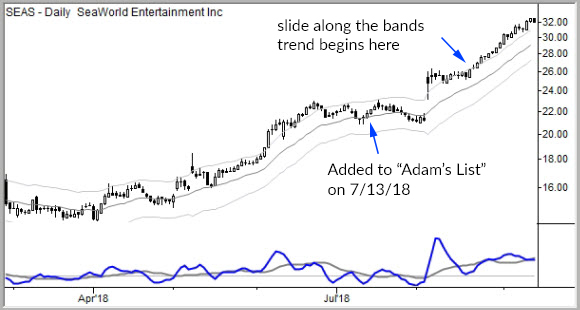Slide along the bands: a trend pattern you should know

Just a quick post here to point out a trending pattern that should be in your toolkit. Take a look at the chart of SEAS above, which shows a particularly powerful trending pattern I have called "slide along the bands". Characteristics of this type of trend are:
- It is a low volatility trend, so the daily ranges contract and there are few, if any, reactions (pullbacks) against the trend
- It is a powerful trend. It can extend much further than anyone would expect.
- It is a one-sided trend, meaning that most market participants are on one side of the trend. when it does end, it will often do so violently.
So how do you use this information? First, when you are on the right side of one of these trends, you simply trail a stop. You don't know how far or how long the trend can go. This sometimes puts us in the absurd situation of wanting our stop to be hit, but having to stay in the market (and make money!) while the trend continues to work for us. Patrick, one of my clients are MarketLife, was sort of "complaining" that he couldn't get stopped out of this stock and had to keep holding it! (Shameless plug, this stock was added to Adam's List, my curated list of best setups in the market on 7/13/18, and, as I write this, the stock has been up nearly 49% from that point. If you want to see more setups and trades like this, check out our zero-risk, "free lunch guarantee" free trial at MarketLife.)
So, if you're on the right side of a market like this, it's kind of a glorious thing, but what if you're on the wrong side? I've also seen traders stuck on the wrong side of a move like this, and it becomes absurd. Maybe your plan is to get out on the first downswing (why? but people do that...), meanwhile it grinds against you every day. It might grind against you for weeks. Or months. No one needs that, so being aware of this kind of trend can help you limit your losses.
Last, these trends don't really have pullbacks. So if you are trapped out of a trend like this, getting in is really hard. In fact, maybe you're better off passing and waiting for another trade. If and when you do get a pullback or pause, it can turn into a complete collapse (see stock indexes Feb 2018, for instance) so limiting your risk on entries is very challenging. You might well decide to not look for entries once a trend like this is underway.
Last thought--this pattern is one example of why I find properly calibrated bands or channels to be so useful. I certainly can trade without any oscillator, but I find an intermediate-term moving average (even though there are no great statistical tendencies associated with that average, from a purely quantitative perspective) to be a useful tool--it structures the data and trains your eye to see it and process it in a certain way. I have tried, but I have a very difficult time trading without this tool. (For reference, I use channels set 2.25 ATRs +/- a 20 period EMA.)



